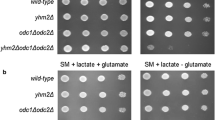Abstract—The investigation of the mechanisms of cytosolic protein degradation is of great fundamental and applied importance. The decrease in the specific activity of formaldehyde dehydrogenase (Fldh1) and formate dehydrogenase (Fdh1) in the wild type strain GS200, the strain with the deletion of the GSS1 hexose sensor gene, and the strain that is defective in autophagy pathway SMD1163 of K. phaffii during short-term and long-term induction with methanol, with or without the addition of the MG132 (proteasome degradation inhibitor), was investigated. It was shown that the duration of cell incubation on methanol had no particular effect on the inactivation of enzymes. The effect of the proteasome inhibitor MG132 was insignificant. Catabolic inactivation of cytosolic and peroxisomal enzymes was damaged in the gss1Δ mutant since glucose signaling was impaired. Fldh1 and Fdh1 are probably degraded via the vacuolar pathway regardless of the duration of methanol induction.




Similar content being viewed by others
REFERENCES
Gellissen G. Hansenula polymorpha: Biology and Applications, Gellissen, G., Ed., Wiley, 2002.
Krasovska, O.S., Stasyk, O.G., Nahorny, V.O., Stasyk, O.V., Granovski, N., Kordium, V.A., Vozianov, O.F., and Sibirny, A.A., Glucose-induced production of recombinant proteins in Hansenula polymorpha mutants deficient in catabolite repression, Biotechnol. Bioeng., 2007, vol. 97, pp. 858–870. https://doi.org/10.1002/bit.21284
Grabek-Lejko, D., Sibirny, V., and Sibirny, A., Regulation of gene expression in methylotrophic yeasts, Postepy Biochemii, 2013, vol. 59, pp. 95–106.
Macauley-Patrick, S., Fazenda, M.L., McNeil, B., and Harvey, L.M., Heterologous protein production using the Pichia pastoris expression system, Yeast, 2005, vol. 22, no. 4, pp. 249–270. https://doi.org/10.1002/yea.1208
Sibirny, A.A., Yeast peroxisomes: structure, functions and biotechnological opportunities, FEMS Yeast Res., 2016, vol. 16, nos. 3–4. https://doi.org/10.1093/femsyr/fow038
Nazarko, V.Y., Futej, K.O., Thevelein, J.M., and Sibirny, A.A., Differences in glucose sensing and signaling for pexophagy between the baker’s yeast Saccharomyces cerevisiae and the methylotrophic yeast Pichia pastoris,Autophagy, 2008, vol. 4, pp. 381–384. https://doi.org/10.4161/auto.5634
Klionsky, D.J., Cregg, J.M., Dun,n, W.A., Jr., Emr, S.D., Sakai, Y., Sandoval, I.V., Sibirny, A., Subramani, S., Thumm, M., Veenhuis, M., and Ohsumi, Y.A., Unified nomenclature for yeast autophagy-related genes, Dev. Cell, 2003, vol. 5, nos. 3–4, pp. 539–545, https://doi.org/10.1016/s1534-5807(03)00296-x
Stasyk, O.V., Nazarko, T.Y., and Sibirny, A.A., Methods of plate pexophagy monitoring and positive selection for ATG gene cloning in yeasts, Methods Enzymol., 2008, vol. 451, pp. 229–239.
Stasyk, O.V., Stasyk, O.G., Komduur, J., Veenhuis, M., Cregg, J.M., and Sibirny, A.A., A hexose transporter homologue controls glucose repression in the methylotrophic yeast Hansenula polymorpha,J. Biol. Chem., 2004, vol. 279, pp. 8116–8125. https://doi.org/10.1074/jbc.M310960200
Stasyk, O.V., Stasyk, O.G., Mathewson, R.D., Farré, J.-C., Nazarko, V.Y., Krasovska, O.S., Subramani, S., Cregg, J.M., and Sibirny, A.A., Atg28, a novel coiled-coil protein involved in autophagic degradation of peroxisomes in the methylotrophic yeast Pichia pastoris,Autophagy, 2006, vol. 2, pp. 30–38.
Nazarko, V.Y., Nazarko, T.Y., Farre, J.C., Stasyk, O.V., Warnecke, D., Ulaszewski, S., Cregg, J.M., Sibirny, A.A., and Subramani, S., Atg35, a micropexophagy-specific protein that regulates micropexophagic apparatus formation in Pichia pastoris,Autophagy, 2011, vol. 7, pp. 1–11. https://doi.org/10.4161/auto.7.4.14369
Polupanov, A.S., Nazarko, V.Y., and Sibirny, A.A., CCZ1, MON1 and YPT7 genes are involved in pexophagy, the Cvt pathway and non-specific macroautophagy in the methylotrophic yeast Pichia pastoris,Cell Biol. Int., 2011, vol. 35, no. 4, pp. 311–319. https://doi.org/10.1042/CBI20100547
Polupanov, A.S., Nazarko, V.Y., and Sibirny, A.A., Gss1 protein of the methylotrophic yeast Pichia pastoris is involved in glucose sensing, pexophagy and catabolite repression, Int. J. Biochem. Cell Biol., 2012, vol. 44, no. 11, pp. 1906–1918. https://doi.org/10.1016/j.biocel.2012.07.017
Polupanov, A.S. and Sibirny, A.A., Cytoplasmic extension peptide of Pichia pastoris glucose sensor Gss1 is not compulsory for glucose signaling, Cell Biol. Int., 2014, vol. 38, no. 2, pp. 172–178. https://doi.org/10.1002/cbin.10189
Hung, G.C., Brown, C.R., Wolfe, A.B., Liuand, J., and Chiang, H.L., Degradation of the gluconeogenic enzymes fructose-1,6-bisphosphatase and malate dehydrogenase is mediated by distinct proteolytic path-ways and signaling events, J. Biol. Chem., 2004, vol. 279, pp. 49138–49150. https://doi.org/10.1074/jbc.M404544200
Brown, C.R., Wolfe, A.B., and Chiang, H.L., The vacuolar import and degradation pathway merges with the endocytic pathway to deliver fructose-1,6-bisphosphatase to the vacuole for degradation, J. Biol. Chem., 2008, vol. 283, pp. 26116–26127. https://doi.org/10.1074/jbc.M709922200
Menssen, R., Schweiggert, J., Schreiner, J., Kusevic, D., Reuther, J., Braun, B., and Wolf, D.H., Exploring the topology of the Gid complex, the E3 ubiquitin ligase involved in catabolite-induced degradation of gluconeogenic enzyme, J. Biol. Chem., 2012, vol. 287, pp. 25602–25614. https://doi.org/10.1074/jbc.M112.363762
Giardina, B.J. and Chiang, H.L., Fructose-1,6-bisphosphatase malate dehydrogenase, isocitrate lyase, phosphoenolpyruvate carboxykinase, glyceraldehyde-3-phosphate dehydrogenase, and cyclophilin a are secreted in Saccharomyces cerevisiae grown in low glucose, Commun. Integr. Biol., 2013, vol. 6, p. 27216. https://doi.org/10.4161/cib.27216
Lowry, O.H., Rosebrough, N.J., Farr, A.L., and Randal, R.J., Protein measurement with the Folin phenol reagent, J. Biol. Chem., 1951, vol. 193, pp. 265–275.
Tuttle, D.L. and Dunn, A.J., Divergent modes of autophagy in the methylotrophic yeast Pichia pastoris,J. Cell. Sci., 1995, vol. 108, pp. 25–35.
Funding
The study was partially supported by a grant of the Polish National Science Center (NCN) DEC-2012/05/B/NZ1/01657.
Author information
Authors and Affiliations
Corresponding author
Ethics declarations
The authors declare that they have no conflict of interest. This article does not contain any studies involving animals or human participants performed by any of the authors.
Additional information
Translated by V. Mittova
About this article
Cite this article
Dmytruk, O.V., Bulbotka, N.V. & Sibirny, A.A. Degradation of Methanol Catabolism Enzymes of Formaldehyde Dehydrogenase and Formate Dehydrogenase in Methylotrophic Yeast Komagataella phaffii . Cytol. Genet. 54, 393–397 (2020). https://doi.org/10.3103/S0095452720050047
Received:
Revised:
Accepted:
Published:
Issue Date:
DOI: https://doi.org/10.3103/S0095452720050047




